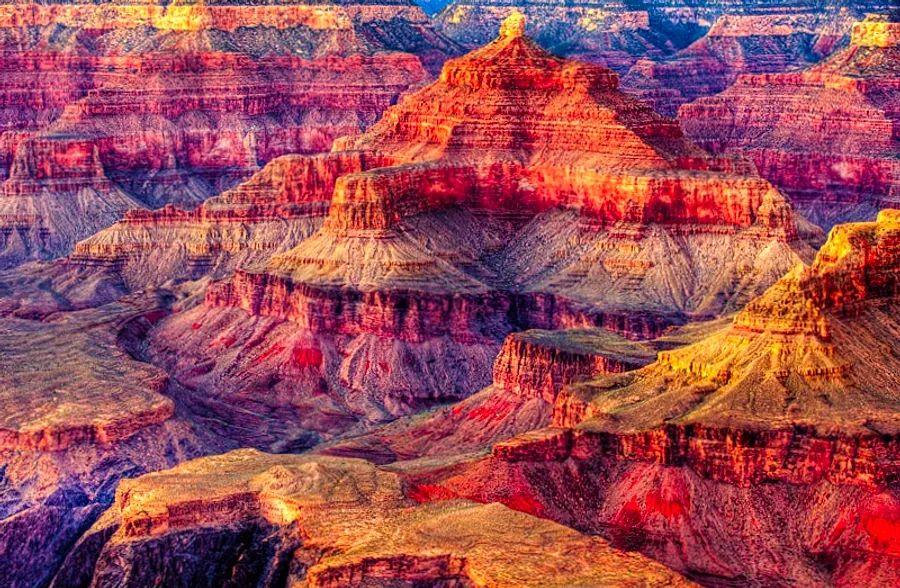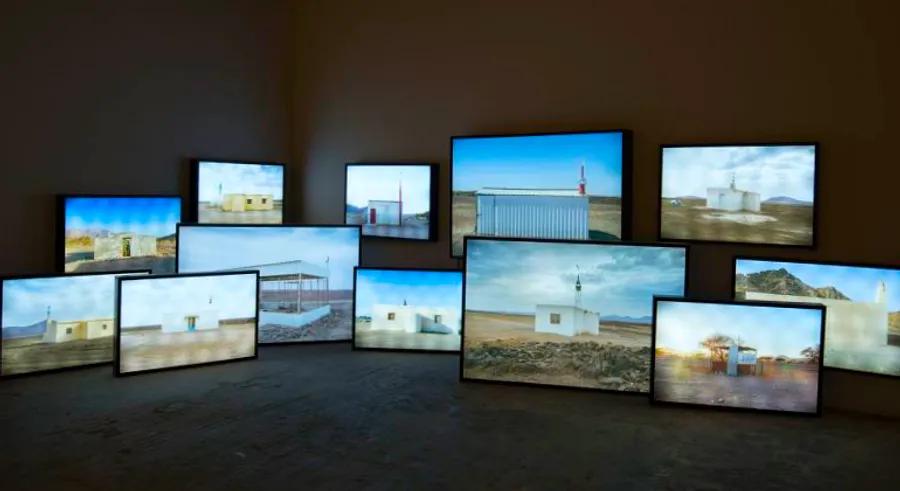Optimal Times to Explore the Grand Canyon

There are countless viewpoints and experiences to enjoy at Grand Canyon National Park, and you could visit a dozen times before truly grasping its vast beauty. However, since not everyone can make multiple trips, we're here to help you determine the best time of year for your visit.
Important: Some areas of the Grand Canyon, including the Desert View Watchtower, are currently closed. Make sure to check the National Park Service's website for the most up-to-date information if you're planning to visit soon.
 A guide leads mule riders up the steep incline of the Bright Angel Trail, famously called Heartbreak Hill. MICHAEL QUINN/NATIONAL PARK SERVICE
A guide leads mule riders up the steep incline of the Bright Angel Trail, famously called Heartbreak Hill. MICHAEL QUINN/NATIONAL PARK SERVICEThe ideal time for pleasant weather
At the South Rim, which sits at an elevation of 6,800 feet and is about two hours north of Flagstaff, Arizona, spring spans from March to May, while fall lasts from September to November. Both seasons feature relatively mild temperatures, with nighttime lows often in the 30s and daytime highs reaching the 60s. The weather is generally favorable for hiking in the Grand Canyon, although occasional rain is possible. Inside the canyon, temperatures during these shoulder seasons range from 55 to 82 degrees.
The North Rim, located at an elevation of 8,000 feet and four hours north of Flagstaff, is accessible only from mid-May to mid-October due to potential snow. When it opens to visitors, temperatures vary from the low 30s to the 60s, warming further into the summer months.
At the West Rim, home to the renowned Grand Canyon Skywalk, spring temperatures are warmer, with lows in the 50s and highs generally in the 80s. September can be quite hot, with temperatures ranging from the high 60s to the high 90s, while October (58 to 84 degrees) and November (46 to 68 degrees) bring more moderate conditions. The West Rim is located about four hours east of Las Vegas.
As expected, summer brings dry conditions and high temperatures. The South Rim often sees temperatures exceeding 80 degrees and can reach up to 100 at the canyon floor. The North Rim experiences milder conditions, with temperatures ranging from the mid-40s to the upper 70s from June to August. The West Rim can be quite uncomfortable during summer, with average temperatures fluctuating between the upper 70s and over 100 degrees.
The South Rim remains accessible during winter, with temperatures typically ranging from the 20s to the low 40s at the rim, while the canyon floor usually sees temperatures between the high 30s and high 50s.
Many visitors view winter as a unique time to experience the Grand Canyon, as there are significantly fewer tourists compared to summer; only about 10% of the annual visitors come during the winter months. If you’re looking to avoid crowds, winter might be the perfect time for your visit.
 BUDDY SMITH/Dinogo
BUDDY SMITH/DinogoThe optimal time to discover the canyon's depths
Most visitors leave feeling unsatisfied unless they venture down into the canyon at least a bit. The perspective from within is vastly different from the sweeping views at the rim. There are various ways to achieve this memorable experience, including guided treks on mules or on foot.
Regardless of the season, hiking in and out of the Grand Canyon should only be done during daylight hours. At the South Rim, you'll find numerous signs warning against attempting to hike to the bottom and back in a single day. The descent to the canyon floor is approximately 7 to 9 miles, depending on the chosen trail; the ascent is quite demanding, taking roughly twice as long as the descent, even for seasoned hikers. If you're still on the trail after sunset, those well-maintained paths can quickly become hazardous. Check the National Park Service website for their hiker FAQs.
Numerous providers offer guided hikes to the canyon floor, as well as mule rides from the South Rim into the canyon.
The ideal time to reach the canyon floor using any method depends on your comfort with heat or cold and the activities that thrill you. If you're looking to enjoy the Colorado River, summer or early fall is best when the water is warmer. (Rafting trips start in mid-June.) A winter visit is perfect for those who prefer fewer crowds and cozy evenings by the fire.
 The Colorado River in Grand Canyon National Park. MICHAEL QUINN/NATIONAL PARK SERVICE
The Colorado River in Grand Canyon National Park. MICHAEL QUINN/NATIONAL PARK SERVICEThe optimal time to escape the crowds
It's likely no surprise, but the Grand Canyon becomes busier when school is out. Expect increased attendance during summer, spring break, and other holidays.
With over 6 million visitors each year, you may encounter long lines for entry, crowded viewpoints, and waits for various services. The National Park Service offers tips for managing crowding at the South Rim.
Visiting when schools aren't on break will lead to a more pleasant experience with fewer crowds. However, if your schedule revolves around school breaks, make sure to consult the NPS crowd survival guide mentioned earlier, and try to enter the park as early as possible in the morning.
 Visitors at the South Rim viewpoint in Grand Canyon National Park. B&M NOSKOWSKI/GETTY IMAGES
Visitors at the South Rim viewpoint in Grand Canyon National Park. B&M NOSKOWSKI/GETTY IMAGESThe ideal time for unique events
In a typical year, Grand Canyon National Park features annual events like an Independence Day parade in July, stargazing nights in June, and a two-day Native American Heritage Celebration in November to commemorate National Native American Heritage Month.
The prime time to observe wildlife
Grand Canyon National Park is home to 447 bird species, 91 mammal species, 48 reptile species, 10 amphibian species, and a plethora of bugs and insects.
The elk residing in the Grand Canyon are among the park's most dangerous animals. Weighing up to 730 pounds, they can become aggressive during fall, their mating season; the NPS advises keeping a distance of at least 100 feet from them.
 Elk are often spotted in and around Grand Canyon Village on the South Rim of Grand Canyon National Park. NATIONAL PARK SERVICE
Elk are often spotted in and around Grand Canyon Village on the South Rim of Grand Canyon National Park. NATIONAL PARK SERVICEGenerally, the optimal time to see mammals — including elk, bighorn sheep, bison, mule deer, javelinas, and mountain lions — is during the park's cooler and quieter periods. Dawn and dusk are prime times for wildlife sightings, with increased animal activity noted in late fall, winter, and early spring. This uptick is due not only to favorable weather but also to the reduced human presence.
Bird watchers may catch sight of rare species, as several threatened and endangered birds reside in the park. These include the California condor, southwestern willow flycatcher, and western yellow-billed cuckoo, among others. In addition to the California condor, various birds of prey such as peregrine falcons, red-tailed hawks, zone-tailed hawks, and Mexican spotted owls inhabit the area. While autumn is the best time for bird-watching, many of these species can be seen year-round.
The prime time for budget-friendly deals
Budget-friendly flights
When searching for flights on Skyscanner, you'll find that the cheapest times to fly from major cities to Phoenix Sky Harbor Airport (PHX) or Las Vegas' Harry Reid International Airport (LAS) vary based on your departure city.
For instance, if you're traveling from New York City to Phoenix, November usually offers affordable fares, although prices surge around Thanksgiving. Typically, flights from Los Angeles are least expensive in June, while those from Boston tend to drop in August. For travelers from Atlanta, October is the best month for budget flights.
Utilize Skyscanner to discover the most economical times to travel from your chosen airport. If you're planning to hike to the canyon floor, it's wise to book that experience first (up to 15 months in advance); this gives you ample opportunity to secure a budget flight. Check out these tips for optimizing your airline miles for domestic trips.
 FISCHERFOTOGRAFIE/GETTY IMAGES
FISCHERFOTOGRAFIE/GETTY IMAGESBudget-friendly accommodations
When visiting Grand Canyon National Park, you can choose to stay within the park or in a nearby town. Each option has its advantages and disadvantages. Staying in the park allows for a more immersive experience, giving you extra time to soak in the canyon's natural beauty. On the other hand, staying outside the park offers more diverse services and the chance to use rewards points for your lodging.
Keep in mind that not all accommodations may be available due to pandemic-related restrictions. Always check directly with the hotel to confirm their availability.
In-Park Hotels: Delaware North and Xanterra Parks & Resorts manage reservations for lodging at the South Rim; rooms can be booked a year in advance. For a stay at Phantom Ranch within the canyon, enter the National Park Service's lottery 15 months ahead of your travel dates. At the North Rim, Grand Canyon Lodge offers a variety of cabins and lodge rooms, with only the Western Cabins featuring two queen beds.
Outside Park Hotels: A delightful and relaxed option for visiting the Grand Canyon is to stay in the quaint town of Williams, located 54 miles south of the South Rim. You can take the Grand Canyon Railway into the park (about two hours and 15 minutes). Two trains depart each morning and return to Williams in the late afternoon, allowing you to enjoy the scenic views without the hassle of driving. A seat in Pullman Class (the budget-friendly choice) costs $67 round-trip for adults and $32 for children. For a ride in the glass Observation Dome, tickets are priced up to $189 for adults and $153 for kids. The Luxury Dome and Luxury Parlor cars are pricier options (with no children allowed in those areas).
 Grand Canyon Railway. BUDDY SMITH/Dinogo
Grand Canyon Railway. BUDDY SMITH/DinogoFor a more conventional hotel stay, the Holiday Inn Express & Suites Williams, located just half a mile from the train depot, offers rooms featuring two queen beds, 42-inch TVs, microwaves, and refrigerators. Rates start at 15,000 IHG Rewards Club points per night, including breakfast.
Wyndham has multiple properties in Williams available for 15,000 points per night, including the Travelodge by Wyndham Williams Grand Canyon, which provides rooms with two queen beds and complimentary continental breakfast, along with options for adjoining rooms.
The Best Western Plus Inn of Williams is another option, costing 16,000 points per night and including breakfast.
Tusayan is the nearest town to the park entrance and features the Best Western Premier Grand Canyon Squire Inn, where rooms with two queen beds start at 24,000 points per night.
Final thoughts
Aside from the North Rim, which shuts down during the colder months, there’s really no bad time to explore the Grand Canyon. It holds its charm year-round. However, depending on your preferences, certain times might be more suitable than others.
We recommend steering clear of July and August due to the heat and large crowds. Instead, aim for a visit between March and May (prior to Memorial Day) or from September to October (after Labor Day). If summer is your only option, consider the quieter North Rim. You might even want to include a visit to Zion National Park, just a couple of hours away, allowing you to experience multiple national parks in one trip.

1

2

3

4

5
Evaluation :
5/5